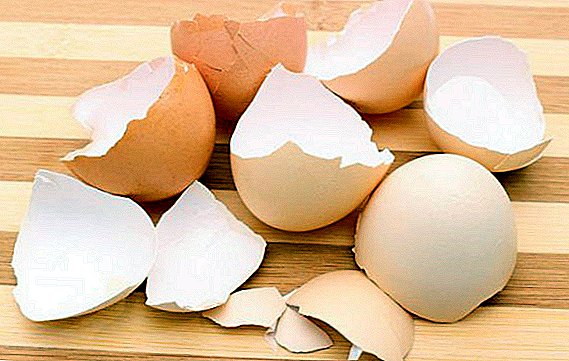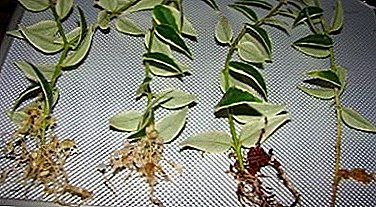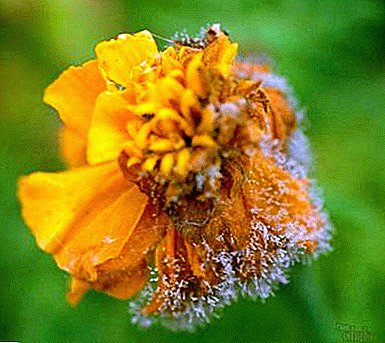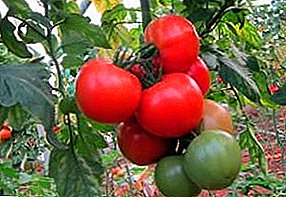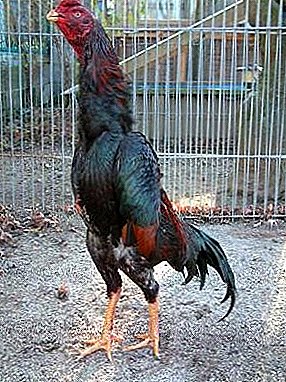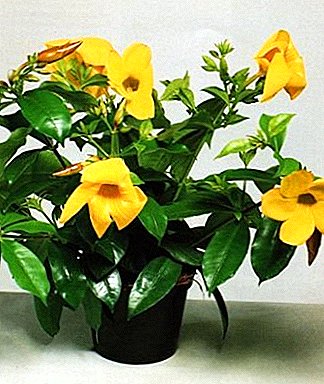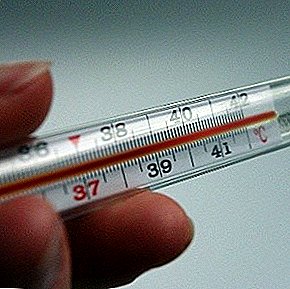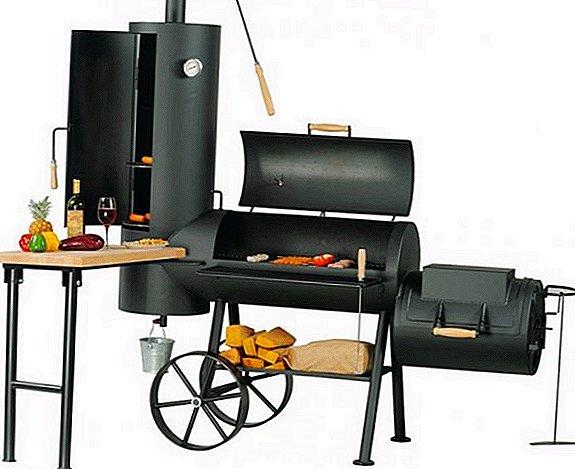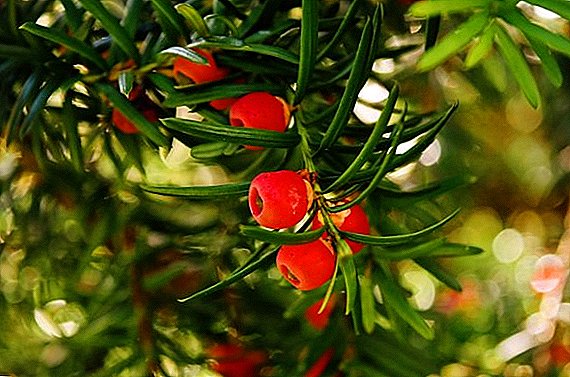 Coniferous cultures attract the attention of summer residents, gardeners and designers due to the fact that they remain decorative throughout the year and are quite unpretentious in their care. One such plant is the yew tree (lat. Taxus), an evergreen conifer and shrub.
Coniferous cultures attract the attention of summer residents, gardeners and designers due to the fact that they remain decorative throughout the year and are quite unpretentious in their care. One such plant is the yew tree (lat. Taxus), an evergreen conifer and shrub.
A tree with beautiful dark green foliage, a reddish stem, a spreading crown and bright red berries will decorate any garden, cottage or country park. His needles grow very densely - this allows for cutting to form hedges and crowns of various shapes, which is especially appreciated by landscape designers. In this article we have collected the most complete information about the advantages of yew, the features of its care, measures to combat diseases, as well as a description of its decorative species.
Did you know? Yew is long-lived. On average, he lives up to one and a half thousand years. However, there are instances that are three to four thousand years old.
Yew: plant description
Yew in the wild is common in areas with a warm climate in the northern hemisphere. It belongs to the family of the same name, numbering eight species, which are distinguished by the height of shrubs and trees, the thickness of the trunk, the quality of wood and the characteristics of foliage.
Four types of decorative culture are used: berry (ordinary, European), short-leaved (Pacific), spiky (Far Eastern), Canadian and their hybrids.
The most popular and valuable is the first type - berry (Taxus baccata). It is distributed in Europe, North Africa and Western Asia. To get an idea of what a yew looks like in this species, here’s some numbers. It grows up to 20 m in height and 12 m in width. The trunk diameter is up to 2 m. It has a short thick trunk and a spreading crown. The length of the needles is 2-3.5 cm. The yew berry has very hard and rotting wood. Thanks to such qualities in the people, he received the name "Negnoy-tree". 
Did you know? In the Middle Ages, big bows of English shooters were made from yew berry. In ancient Egypt, sarcophagi were made from it. Today, yew furniture is popular, thanks to which the area of this tree has been greatly reduced recently. Yew wood has bactericidal and antiseptic properties.
Short Leaf Yew (Taxus brevifolia) grows in America, cultivated in Western Europe. It reaches a height of 6-12 m. It has a heavy, strong wood of red-pink color.  Barrel Peaked Yew (Taxus cuspidata) grows by 15 m, some specimens roll over for 20 m. Many of its forms are included in decorative culture. Especially prized miniature varieties "Nana" and "Minima", which can be from 30 cm to 1 meter in height.
Barrel Peaked Yew (Taxus cuspidata) grows by 15 m, some specimens roll over for 20 m. Many of its forms are included in decorative culture. Especially prized miniature varieties "Nana" and "Minima", which can be from 30 cm to 1 meter in height.  Also, due to its miniature size is actively cultivated Canadian yew (Taxus canadensis). Shrubs of this species are rarely above one meter in height.
Also, due to its miniature size is actively cultivated Canadian yew (Taxus canadensis). Shrubs of this species are rarely above one meter in height.  Yew - frost-resistant plants, depending on the species withstand temperatures from -30 to 40 Сº. Also a feature of these plants is that they do not have resin, and hence the coniferous smell.
Yew - frost-resistant plants, depending on the species withstand temperatures from -30 to 40 Сº. Also a feature of these plants is that they do not have resin, and hence the coniferous smell.
Trees and shrubs of this family are resistant to short-term droughts due to the long and powerful root system. They are characterized by a slow growth rate - by the age of 10 they grow only by a meter. A year can give a gain of 25 cm in height and 20 cm in width. Begin to fructify at the age of 20-30.
Next, we will talk about the features of growing yew.
Important! Shoots, bark, berries and yew seeds are poisonous to humans and some domestic animals.
Growing yew: where best to plant a plant
The main plus of a yew is its unpretentiousness in leaving and at landing. Nevertheless, it must be remembered that the negative factors for the tree are:
- water stagnation;
- strong winds;
- acid soils;
- gas pollution (for some species);
- prolonged droughts;
- dry air.

Climatic conditions for growing
Since in the wild, yew grows in warm climates, it is better to select a well-lit place when planting in the open field at a dacha. However, if there is no such area or you have planned a shaded area for a bush, the yew will grow there, although it will slightly lose in its decoration and growth. At the same time, growing in the shade of other trees, yew better tolerates frost.
It is also desirable that the landing site is protected from drafts. It is important to know that not all species of this tree are suitable for landscaping urban parks and squares, because they do not tolerate polluted air.
Soil selection
Shrub prefers soil fertile, light, with good drainage. The optimum composition of the soil is sand, peat, sheet or turf ground (2: 2: 3). Good when planting add coniferous forest land. Although we note that yew survives on poor soils, the only thing that does not tolerate - soils with high acidity and humidity.
Berry yew feels good in areas where alkaline or slightly acidic soil grows poorly on the ground with an excess of moisture. Also slightly acidic soil prefers a Canadian look. Pointed yew does not tolerate acidic soils. And the most unpretentious in choosing the land is the hybrid of the berry and peaked species - yew average. It grows well on slightly alkaline and neutral soils.
Planting yew at the cottage
Planting yew on the dacha does not entail much effort. If you follow the recommendations for preparing the pit and placing a seedling in it, the yew will quickly and successfully take root in the open field.
How to prepare the landing pit
With a single landing, the depth of the landing pit should be at least 65-70 cm and 20-25 cm wider than the root system. If you plan to plant a hedge, the trench is dug to a depth of 0.5 m for one row, with a two-row landing - 70 cm.
Yew loves drained soil, so before planting it, it is advisable to cover the bottom of the pit with broken brick, pebbles, river sand, gravel 20 cm. A layer of soil is poured over the drainage.
The distance between the plants should be 1.5-2.5 m. If a hedge is planted, leave intervals of 50 cm.
The scheme of planting sapling yew
The best period for landing will be the end of August - October. Yew from the container can be planted throughout the warm season.  When planting a sapling from a container, it is carefully released and planted together with a clod of earth. Next, the rhizome is covered with soil. It is important to ensure that the root neck is located above the ground. The seedling must be poured abundantly; the stem should be mulched with peat or compost.
When planting a sapling from a container, it is carefully released and planted together with a clod of earth. Next, the rhizome is covered with soil. It is important to ensure that the root neck is located above the ground. The seedling must be poured abundantly; the stem should be mulched with peat or compost.
When planting, fertilize the soil with a complex of minerals. The following dressing of the seedling is carried out in the spring.
Reproduction yew
Yis can reproduce both seeds and vegetatively - cuttings. The first method is more costly and time consuming.
Seed method
Yew seeds retain their germination properties for four years; in the case of spring cultivation, they will need stratification. They will need to be stored at a temperature of + 3-5 ° C in a refrigerator for six to seven months. This will ensure their best germination.
After stratification, in March, the seeds are sown in a container or cups with a light substrate, which must first be sterilized (can be in the oven or pour in boiling water). Planting depth - 0.5 cm. Next, you only need regular watering. Germination period is about two months.
Also, the seeds are planted directly after harvest - in October-November. You can try to sow the seeds and immediately in open ground. To do this, before planting, they are briefly soaked or kept for several days or weeks in wet sand at zero temperature. In autumn, sprouted seedlings will reach a height of 10 cm, in a year - 15-25 cm.
You can try to sow the seeds and immediately in open ground. To do this, before planting, they are briefly soaked or kept for several days or weeks in wet sand at zero temperature. In autumn, sprouted seedlings will reach a height of 10 cm, in a year - 15-25 cm.
Seed method is mainly used for breeding yew in nurseries.
Plant cuttings
A simpler way to propagate yew, will be the separation of the cuttings. This is how tree growers most often propagate. In species that have a vertical growth of branches, crowns in the form of cones and pyramids, cuttings taken from the apical shoots.
In bushy varieties for propagation and side shoots are used. If cuttings are taken from old trees, they must be treated with growth stimulants.
The best time for grafting yew - autumn (October). Although this can also be done in the spring, in April-May.
The cutting length is 15–20 cm. There should be several lateral processes. It is also necessary to leave a piece of uterine wood. The lower part is cleared of needles. For rooting, the cuttings are planted in containers with a mixture of sand and peat (1: 2).
Roots must appear within three months. Then they are transplanted into pots and kept in a warm place, for example, in a room, a greenhouse, or a greenhouse.
Rooting occurs within three months. If cuttings were in the fall, then the rooted cuttings can be planted in open ground in May. When spring grafting is done in September.
When planted immediately in open ground, the yew breeding period for cuttings is six to seven years. If they are planted under the film, the process will accelerate by two years. Before winter, the soil under planted cuttings is mulched using peat, sawdust or pine needles.
Another method of breeding yew, which is used very rarely, is grafting. Basically it is used to remove the pyramidal forms of berry yew.
How to care for a yew in the country
As you can see, growing a yew is simple: the technology of planting it will not cause any particular difficulties, and it will not take much trouble and care for the plant. It will mainly consist in removing weeds, regular watering, loosening of the trunk circle and pruning of branches.
The first two or three years, young plants should be covered for the winter. Since all coniferous plants suffer from spring burns, in early spring, the yew should be covered with a spruce twig, nonwoven fabric or kraft paper from the sun.
Watering plants
Regular watering require only young plants up to three years. They are watered at the root once a month. For one shrub use no less than a bucket of water. In the future, thanks to the powerful root system, the yew will look for moisture itself. It is necessary to help him in this only during especially dry periods. At the same time, it is desirable to spray (sprinkle) the crown. 
Soil care
The soil under the yew must be periodically loosened to a depth of 10-15 cm. It is especially important to do this in the first two or three years after planting, after watering and the formation of a crust. This will allow the roots to better feed on oxygen.
Also, the ground must be mulched. Sawdust, pine needles and peat are covered with a layer of 8-10 cm in the near-trunk circle.
An important condition for the maintenance is weeding in the immediate vicinity of the tree.
Top dressing yew
The first dressing is made immediately upon planting at the rate of 1 l of the substrate - 1 g of nitroammofoski and 15 mg of copper sulphate. In the future, yew berry, as in principle, and other species will need to be fed a year after planting in open ground.
Annual fertilizers are applied during the growing season. With an interval of two weeks, yews are fertilized with Florovit, Kemira-Universal or others. 
Pruning plants
The tree perfectly tolerates both a formative haircut and strong sanitary pruning, which is necessary for dry and damaged branches. The ability of the yew to produce new shoots is maintained throughout its long life. After a strong pruning, the plant recovers easily and fairly quickly.
Every year, yew branches, like those of other conifers, are cut to one third the length. This can be done in almost any period - in spring, summer, autumn. Apply a pruner (for pruning branches), scissors scissors (for the formation of the crown). For pruning needles need a garden knife. To remove thick branches, do not do without a saw.
In order for the tree to have a neat appearance, produce formative pruning. Haircut yew allows you to give it a variety of forms: ball, cone, trapezoid, cube, etc.
Perfectly on the site look compositions from different coniferous plants - larch, spruce, thuja, juniper, fir, pine, cedar, cypress, cryptomeria, myriac foxtail.
Diseases and pests of yew
In general, yew is characterized by high resistance to diseases and pests. However, unfortunately, not one hundred percent. This coniferous tree can affect fungal diseases - fusarium or tracheomycous wilting, shyutte, rot, biortella cancer, fomoz, pestalocial necrosis of shoots. In addition, lichens and mosses can form on the tree. Treated trees must be treated with fungicides.
Important! Caring for a yew in the garden will sometimes require the use of chemicals. When processing wood with fungicides, you must follow the rules of personal safety. Spraying is carried out in calm weather. Hands should be protected by gloves, eyes - glasses, nose and mouth - by mask.
The yew is also affected by pests. It can be attacked by a yew galley, a yew false shield, a scosary. Prophylactic and therapeutic sprays of karbofos, nitraphine and other fungicidal preparations are used against parasites.  Yew - a tree with the simplest growing conditions. It is this feature and unusual beauty that give reason to widely use the yew in landscape design, to decorate gardens and cottages. This conifer is beautiful in a single planting.
Yew - a tree with the simplest growing conditions. It is this feature and unusual beauty that give reason to widely use the yew in landscape design, to decorate gardens and cottages. This conifer is beautiful in a single planting.
Most often from it make hedges and borders. This is the best plant for topiary compositions (green sculptures), background in rock gardens. In group plantings yew is beautifully combined with thuja, juniper, Japanese quince.



